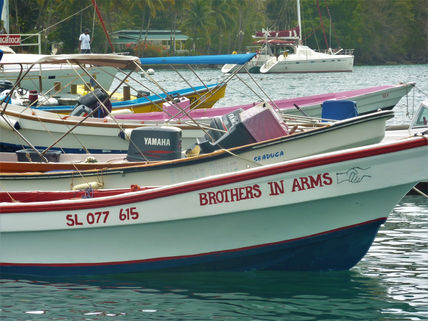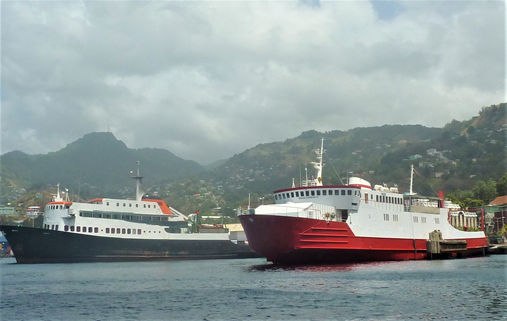Hello Family & Friends from the Royal Clipper, this is our last report on plying the Grenadines, the last vestiges of our 2 weeks island hopping in the Caribbean being the islands of Saint Vincent & The Grenadines, Martinique and Saint Lucia.
Leaving our portage on Grenada, we motored NE to the island of Saint Vincent, an 85 mile distance, where we anchored off of the capital, Kingstown, with a population of roughly 16,000 of the island’s total of 110,000. As our tender neared the shoreline, the hillside’s colorful houses came into view showing their quintessential Caribbean colors of green, red, orange, and yellow. We spent the day roaming around town as well as a great deal of time at the 20 acre St. Vincent & Grenadines Botanic Gardens, established in 1765, the oldest in the Western hemisphere, with the distinction that Captain Bligh (of British Royal Navy and Mutiny on the Bounty fame) brought breadfruit trees here for the landowners to propagate and profit from. Workers were tending to the ferns and other exotic biota and resting from the tropical heat, with squawking parrots amidst the Sausage and Cannonball trees. We had some fun with plants (Maggie behind a palm frond playing peekaboo) and meeting Alvin, a friendly and informative employee who gave us some history and suggestions of what to do on the island.
Following the several hours there, we chose to wander around Kingstown, taking in the St. Mary’s Church & Roman Catholic school, espying gargoyles and children peering down at us through the stone pillars at the rooftop as we passed by on the street. We scrutinized the various religious trappings inside this 19th century Romanesque structure, including inspirational prayers and sayings.
On the streets, we came upon political statements, some we understood…“Injury Invites Reward”, a reparations slogan denoting the desire to rename things to signify the break from the colonial past. Others like “Mister, Why Yo Stone God Church?”, painted on the side of a long and dilapidated wooden structure, left us clueless. We did find our way to the 200 year old Kingstown Cemetery, which showcased goats grazing in and around the headstones. We were done now with this capital town and got back to our vessel by noon for lunch, after which we motored the waters 9 miles south to the island of Bequia, an isle measuring 7 square miles, housing a population of 5,000 with African, Scottish & Carib ancestries. We anchored in Admiralty Bay, along with some industrial ships, taking one of our ship’s Zodiacs ashore for the afternoon. Walking into Port Elizabeth, we came across small businesses like Rennie’s Music Shop (which also sold cooking gas) and stumbled on the Penthouse Bar, purchasing a beer before following a path over the headland for about 25 minutes, arriving at our destination, the pristine Princess Margaret Beach, lounging in its warm waters before returning to our vessel.
The following morning, after a night of motoring northward, we arose to see ourselves anchored offshore of the island of Martinique (430 sq. miles), a French territory, 95 miles NE of St. Vincent. We participated in deck-side exercises before breakfast, eventually taking a taxi into the capital of Fort-de-France (population of 90,000). Our driver let us out at the cultural center in 95 degree weather, not pleased with our tip but with 11 years distancing this report from that day, the details are long forgotten, only a tinge of the emotions remaining. We checked in at the center to see what might be of interest to us, ending up purchasing café au laits and wandering around the town on our own, viewing more Caribbean colored housing along with multiple-storied rundown apartment buildings, laundry hanging off their small balconies. We did see the looming specter of Fort Saint Louis on the hillside but weren’t able to visit it, clicking a photo from afar. Its history dates back to a battle in 1781 which was part of the American War of Independence. We eventually returned to the Royal Clipper for an evening of eating, laughing and sharing our day’s exploits.
The following day found us retracing our steps SW to the last island we would spend time on, Saint Lucia (a 27 mile long island covering 238 sq. miles, with a population of 185,000), which we had motored by on our way to Martinique. The early history of Saint Lucia includes being settled by the French in the mid-17th century, with British and French control see-sawing for 150 years, involving sea battles between the two countries. Finally, in 1838, Saint Lucia was annexed to the Government of the British Windward Islands, joining Barbados, Grenada, St. Vincent & Tobago. It remained so until 1959 when that Government entity was abolished. St. Lucia became a federated state associated with the United Kingdom in 1967. Although it achieved independence in 1979, St. Lucia remains a member of the British Commonwealth.
We dropped anchor off the west coast and took a tender to Marigot Bay inlet, passing by the ferry dock on our way deeper into this safe harbor from storms, which is located 4 miles south of the capital town of Castries. On our own for the next couple of hours, we ventured further into the inlet, taking a small local boat over to an area with an array of small businesses ensconced in shanty-like structures. One appealed to us, which was run by a friendly and outgoing Ethiopian who called himself “Johnny-be-Good”, whose signage indicated we could purchase rum. As it turned out, he had none at hand and had to call up an “Auntie” who lived up in the hills and would bring some homemade spice rum down to us. In the meantime we, along with Mary, enjoyed some of the excellent rum punches that Johnny provided straight from a large plastic vat. It took an hour for “Auntie” to show up with a pint-sized plastic bottle, bearing a plastic orange cap and a small white label reading “St. Lucian Local Spiced Rum”. We knew there were rum distilleries on this island, however, the idea of this bootleg purchase was too good to pass up, so, in the meantime, we roamed around looking at the bevy of brightly colored small water craft, some of personal usage, others for taxiing this area, one of which we rode in on our way for a swim, espying a local, paddling on his small float, loaded with bananas. Bananas are Saint Lucia’s second biggest export product, just ahead of beer, one brand of which, Piton, is named after the two volcanic “plugs” on the SW tip of the island (named “Gros” and “Petite” Piton, the shortest at 2,400 feet, the tallest, 200 feet more). We were able to snag a photo of these twins from our schooner before departing from our final day before sailing on back to Barbados to catch our flight back home. Hope y’all have enjoyed this little Caribbean milestone birthday (90th) getaway.
Post-Trip Note:
Since this trip, Birthday Boy Bob passed away and his daughter, Pam, along with her German friend, Uli, traveled with Maggie and me for our 40th wedding anniversary in Europe in 2015. She brought along some of his ashes to spread in the Austrian Alps, commemorating many of their trips together in Austria over the years. Maggie and I were so fortunate to have celebrated with Bob on his milestone birthday and will treasure this seagoing adventure for a long time.

























